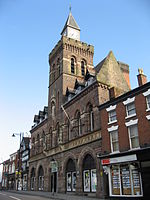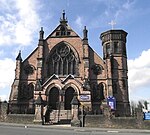Newbold Astbury
Cheshire geography stubsCivil parishes in CheshireVillages in Cheshire

Newbold Astbury (often just Astbury) is a village and civil parish in the unitary authority of Cheshire East and the ceremonial county of Cheshire, in the north-west of England. Newbold Astbury is situated 1+1⁄2 miles (2 km) to the south-west of Congleton on the A34 road to Scholar Green; the A34 forms one side of the triangular village green. The civil parish holds a combined parish council meeting with the adjacent civil parish of Moreton-cum-Alcumlow, which is consequently called Newbold Astbury-cum-Moreton Parish Council.
Excerpt from the Wikipedia article Newbold Astbury (License: CC BY-SA 3.0, Authors, Images).Newbold Astbury
Newcastle Road,
Geographical coordinates (GPS) Address Nearby Places Show on map
Geographical coordinates (GPS)
| Latitude | Longitude |
|---|---|
| N 53.148 ° | E -2.237 ° |
Address
Newcastle Road
Newcastle Road
CW12 4RP , Newbold Astbury
England, United Kingdom
Open on Google Maps









